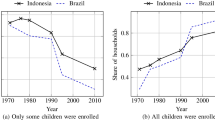Abstract
This paper considers the implications of the financing of government services to children when fertility decisions are endogenously determined. In particular, it is shown that when the services are financed by taxation, the equilibrium outcome is biased away from the socially preferred result. The bias results in higher fertility rates and lower economic growth rates than the efficient social optimum. This arises because each household internalizes the benefits, but not the costs of the tax-financed services. We consider alternative methods of financing the public provision of services and find that a combination of taxation and vouchers can eliminate the bias in the equilibrium outcome.
Similar content being viewed by others
References
Arrow K (1971) A utilitarian approach to the concept of equality in public expenditures.Quarterly Journal of Economics 86:409–415
Barro RJ, Becker GS (1989) Fertility choice in a model of economic growth.Econometrica 57:481–501
Becker GS (1988) Family economics and macro behavior.American Economic Review 78:1–13
Becker GS, Lewis HG (1973) On the interaction between the quantity and quality of children.Journal of Political Economy 81:5279–288
Becker GS, Murphy KM, Tamura R (1990) Human capital, fertility, and economic growth.Journal of Political Economy 98:S12-S37
Besley T, Coate S (1991) Public provision of private goods and the redistribution of income.American Economic Review 81:979–984
Boadway R, Marchand M (1995) The use of public expenditures for redistributive purposes.Oxford Economic Papers 47:45–59
Brander JA, Dowrick S (1994) The role of fertility and population in economic growth: Empirical results from aggregate cross-national data.Journal of Population Economics 8:1–25
Cigno A (1993) Intergenerational transfer without altruism: Family, market and state.European Journal of Political Economy 98:505–518
Eichenbaum M, Hansen LP, Singleton KJ (1988) A time series analysis of representative agent models of consumption and leisure choice under uncertainty.Quarterly Journal of Economics 103:51–78
Feenstra RC (1986) Functional equivalence between liquidity costs and the utility of money.Journal of Monetary Economics 17:271–291
Glomm G, Ravikumar B (1992) Public versus private investment in human capital: Endogenous growth and income inequality.Journal of Political Economy 100:818–834
King RG, Plosser CI, Rebelo ST (1988) Production, growth and business cycles.Journal of Monetary Economics 21:195–232
Kuznets S (1960) Population change and aggregate output. In:Demographic and economic change in developed countries. Princeton University Press, Princeton
Mankiw NG, Rotemberg IT, Summers LH (1985) Intertemporal substitution in macroeconomics.Quarterly Journal of Economics 100:225–251
Nerlove M (1974) Household and economy: Toward a new theory of population and economic growth.Journal of Political Economy 82:S200–218
Palivos T (1995) Endogenous fertility, multiple growth paths and economic convergence.Journal of Economic Dynamics and Control 19:1489–1510
Palivos T, Wang P, Zhang J (1997) On the existence of balanced growth equilibrium.International Economic Review(forthcoming, Vol 37)
Palivos T, Yip C (1993) Optimal population size and endogenous growth.Economics Letters 41:107–110
Ploeg F van der, Alogoskoufis GS (1994) Money and endogenous growth.Journal of Money Credit and Banking 26:771–791
Poterba JM (1994) Government intervention in the markets for education and health care: How and why?NBER Working Paper No. 4916, November 1994
Razin A, Ben-Zion U (1975) An intergenerational model of population growth.American Economic Review 65:923–933
Rebelo S (1991) Long-run policy analysis and long-run growth.Journal of Political Economy 99:500–521
Scotese C, Wang P (1995) Can government enforcement permanently alter fertility? The case of China.Economic Inquiry 33:552–570
Simon J (1977)The economics of population growth. Princeton University Press, Princeton
Simon J (1981)The ultimate resource. Princeton University Press, Princeton
Tobin J (1970) On limiting the domain of inequality.Journal of Law and Economics 13:263–277
Wang P, Yip C, Scotese C (1994) Fertility choice and economic growth: Theory and evidence.Review of Economics and Statistics 76:255–266
Usher D (1977) The Welfare economics of the socialization of commodities.Journal of Public Economics 40:151–168
World Bank (1984)World development report 1984. Oxford University Press, New York
Author information
Authors and Affiliations
Additional information
We are grateful for comments from Alessandro Cigno and two anonymous referees.
Rights and permissions
About this article
Cite this article
Palivos, T., Scotese, C.A. Fertility, growth and the financing of public education and health. J Popul Econ 9, 415–428 (1996). https://doi.org/10.1007/BF00573073
Received:
Accepted:
Issue Date:
DOI: https://doi.org/10.1007/BF00573073




